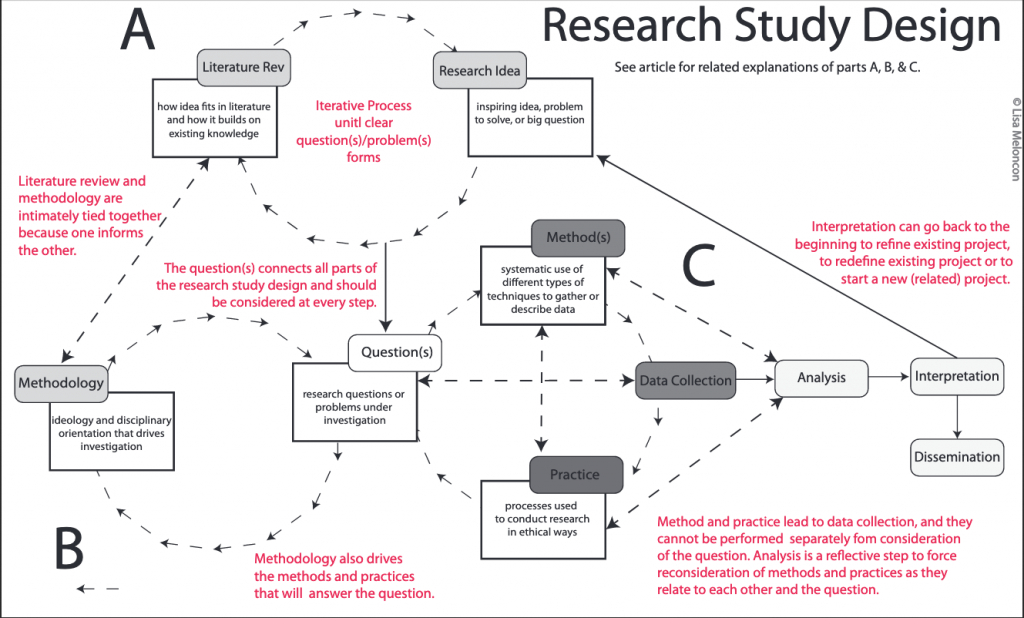Research is not linear or circular. It’s messy and it’s interative.
The diagram below is my attempt to get us to think through research a little differently than you may have before. This is a work in progress, but it’s a start to get us passed thinking about research as something that has pre-defined steps in a linear path.
The diagram represents what I refer to as research study design.
Typically the research process, what we are referring to here as research study design, has been portrayed as being something of a linear process with the following steps:
- Research idea
- Literature review
- Formulate research problem or question
- Research design (method, sample, procedures, etc)
- Data collection
- Data analysis
- Interpretation
- Dissemination/publication
A search on google images for “research design” will generate thousands of images that portray these steps in a linear design such as

Or one may see an image where the steps are placed in a cycle or circle to signify that the process is ongoing such as

Existing models within the field (and many outside of it) try to simplify what is in actuality a complex and difficult process. We feel that these models are not only limiting, but they portray a fundamental misunderstanding of the research process because they fail to explicitly show the complicated, overlapping and messy steps and the necessity for continuous reflexive action and circling back to ensure the project is moving forward in a way that the question can potentially be answered.
We wanted our model to try and capture the ongoing iterative and reflexive process that good research study design requires. Particularly, as more empirical research is being conducted in technical and professional communication the need for a better representation and explanation of the research process becomes imperative. Empirical research is a messy and complicated process that needs a model that better represents it. Technical and professional communication scholars and practitioners need

We have labeled the figure with three parts A, B, and C, as a way to be able to talk about it. However, the research study design needs all of these parts to be successful.
To begin, the dotted lines and circles represent an ongoing process. The research must move through the different parts and often, it takes more than one (or even two passes) to ensure that those steps have been completed to the part that the researcher can move on.
Quadrant A represents the beginning of a research project and the beginning of the study design. It begins with some big idea or inspiration or even a problem that may need to be solved. (The latter is particularly true in applied research such as that found in workplace studies.) Most initial ideas have to be narrowed and focused to be able to be researched. For example, [example of fine big question but one that really isn’t researchable for a study]. Since we are discussing academic research, the best way to narrow the big idea of topic into a researchable question is through a literature review. The literature review serves two distinct and equally important purposes. First, it helps the researcher narrow down the idea into a researchable question, and second, it situates the idea and question into the exiting body of literature. Many researchers do not adequately do the second part of the literature review step. For example, it is true that a researcher wanted to find research on communication strategies of widget workers who work in a cube office setting in the Midwest that there will likely be no hits. But, the overall idea of communication strategies in a technical workplace has been studied, and the literature in this area needs to be read and engaged with to not only help with research study design, but also to help when writing up results.
An iterative cycle needs to be completed up until the point that the researcher has a firm grasp on how the project fits in and builds upon existing research and what the actual question/problem is.
All during this process quadrant A is associated directly with quadrant B through research methodology, which we’re using here to mean the disciplinary orientations that are guiding the research process. One cannot perform an appropriate literature review if one is unfamiliar with the disciplines journals and theoretical orientations. For example, in technical and professional communication, we have five major journals and a series of second tier journals where TPC research has been welcomed through the years. We are starting to see a growing number of research articles being published in rhetoric journals if the research using a rhetorical theory approach. In other words, without a grounding in the field, it is difficult to know where to start and what will be recognized by those reviewing your work. This is why methodology is connected with the literature review in a two-way relationship. The same is also true for methodology’s relationship with the research question. This relationship however is cyclical, which means the question can shift based on the disciplinary orientation.
The research question(s)/problem(s) connects quadrant B to quadrant C, where much of the actual work of the research study design is conducted. If researchers have managed to craft a solid research question, then it is time to determine how to gather data or information that when analyzed will help answer the research question. Quadrant C illustrates that the question is the guiding factor for the method(s) selected and the practice(s) of conducting the research study. There is again an iterative and circular process where the methods and practices return to the question to ensure that the data being collected is adequate to answer the question. This is why data collection and question are connected by a dotted line, while also remaining in the same iterative circle with methods and practices.
When it is time for a first round at analysis is connected back to methods and practices (which in turn puts it back into the cyclical process with questions and data collection. This location and connection ensures that analysis is reflexively focused on adequately answering the question with the methods and practices selected. If not, then the researcher can shift and begin the process again. In any either case, the data collection and subsequent analysis is still connected to the methodology and question being investigated.
You can read more about my views on research in this blog post (opens in new window).


